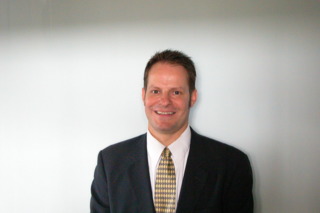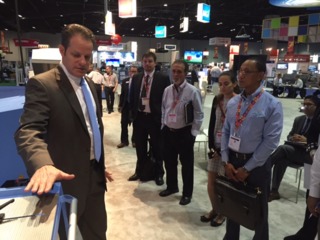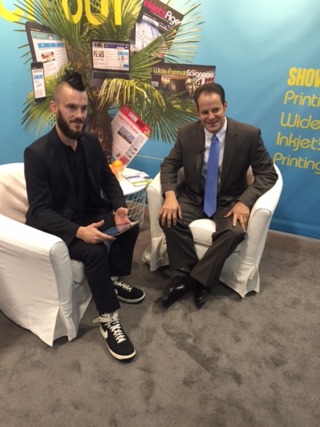Executive Q&A: Andy Fetherman, Vice President of Sales and Technology, Muller Martini
Fetherman shares his journey through the graphic-arts industry, and his delight in being a part of the digital revolution.

1. Tell us a little about your company, the segment of the market it serves, and what you consider to be your “core” users.
Muller Martini was founded in 1946, and today it is a leading producer of print finishing solutions for digital, offset, and hybrid printed products. Our customers are commercial and book printers, trade binderies, digital book manufacturers, and newspapers. In addition, through MMServices, we provide performance-enhancement programs which offer continual improvement for equipment and workflow.
2. How did you get involved with the company? What is your background before that?
My 30-plus years in the graphic-arts industry has afforded me opportunities in nearly every phase of the printing process. With a degree in electrical engineering, I began my career at a prepress company in 1986 assembling film negatives for printing plates, or “stripping” as it was referred to before the emergence of computer-aided techniques. I also worked on the actual presses. In 1989, I was hired as an electrical engineer at Heidelberg. When the company relocated to Atlanta, my career moved to the finishing field. I was hired by Muller Martini in 1994 as a product manager in their press division. And, it was as Muller’s director of digital solutions where I was able to really immerse myself in the future: digital technology and integration.
3. What do you consider your greatest achievement in this market to be?
Being able to work with clients over the past 15 years to help them successfully migrate onto the digital playing field. It wasn’t easy in the beginning, because in essence, we were predicting the future. But, today, the world’s largest printing companies have migrated to digital print manufacturing, not to mention the thousands of small-to-medium sized printers and trade binderies.
3. If there was anything you could change, either about your career in regards to the print industry, your company, or the market as a whole, what would it be and why?
When we brought digital technology to market, sometimes we were way ahead of the curve; and, there were other times when we didn’t quite understand the requirements. So, we went “back to the drawing board” time and time again. Some may view that as setbacks that stifled progress. But, my experience has shown that those kinds of challenges helped us to generate the portfolio we have today, not to mention a significant knowledge base that helps our customers succeed in this dynamic printing world.
In terms of the market, I would like to see greater focus on the finishing challenges inherent in a variable print world. Too often, people look at the print side before they look at finishing. But, given the complexities of today’s print products, it’s more important than ever before to look earlier in the process at your finishing requirements.
4. What do you consider the greatest challenge to be for the industry right now? Why?
The ongoing migration into digital and the myriad challenges that presents in terms of inkjet printing, operator training, inventory management, direct mail compliance, etc. All told, meeting these challenges depends on the industry’s ability to embrace digital printing and digital finishing technologies and the workflow associated with radically different run sizes and increased variability. At the end of the day, it’s all about achieving more quality, reliability, and content integrity.
5. What do you consider the greatest asset to be for the industry right now? Why?
The challenges of variability have resulted in our industry’s proficiency to deliver a highly personalized message via such innovations as dynamic finishing and touchless workflow. These innovations have helped to reinforce print’s resiliency and adaptability, not to mention its sustaining value. So, perhaps our greatest asset is being able to bring more value to print’s end users through the delivery of highly focused, highly relevant information.
6. In your opinion, what have been the biggest changes to the way we communicate with one another in the past few years? How would you recommend this industry take advantage of that?
Today’s world communicates through a combination of social media, electronic media, print, and face-to-face. And, the good news is that the doomsayers of print were wrong. Not only is print stronger than ever, it continues to uncover new ways to remain relevant. For example, it's welcomed connectivity with electronic media in the form of QR codes and augmented reality, as well as the finishing of a personalized print product that’s mixed with hybrid and digital content.
7. Looking ahead, what major innovations or technologies do you believe will shape the future of the industry? Why?
The continual emergence of inkjet and its ability to achieve higher quality, higher speed, and more substrate is going to open up opportunity beyond legacy markets like books into commercial, high-end catalog, and magazine work, which represent powerful venues for variability. And, hand-in-hand with that comes finishing technology and its ability to do incredibly dynamic matching and real-time compliance monitoring that adheres to federal mail regulations. Those types of capabilities will shape the future of the industry and keep print viable and companies profitable.
And, let’s not forget that inkjet will co-exist with offset for the future to come. That means having finishing technology that can embrace both, combine them when necessary, or handle them agnostically in order to achieve optimum efficiencies on the production line.
Muller Martini’s “Finishing 4.0,” or the future of finishing, addresses many of these challenges, including variability of product sizes and content; seamless connectivity among machines; and a touchless workflow that drives makeready in ultra-short run environments.
8. What is the biggest piece of advice you would give to printers and others involved in this industry?
Look at your complete production cycle, beginning with pre-press through to the finished product. In other words, don’t get overly focused on one segment. When you’re looking at print engine technologies, look at the workflow that’s required to drive it; and, at the same time, look at the finishing that’s needed to make it into a saleable product. The bottom line is you can’t buy an asset in a bubble anymore. You have to buy assets that complement other assets, whether it’s software, a print engine, finishing equipment, inserting machines, etc. Because as variability becomes more ubiquitous, all facets of the production cycle need to be optimized.
10. Is there anything else you would like to share with our readers?
As you look at the future of your company, make sure you partner with others who share similar ideology in terms of design and engineering. A scalable philosophy enables you to make decisions today that might change tomorrow. So, your technology needs to be flexible and component driven. Because there will be changes, which is why it’s critical to work with partners who provide the investment protection that lets you grow into your assets and adapt them for future demands.


